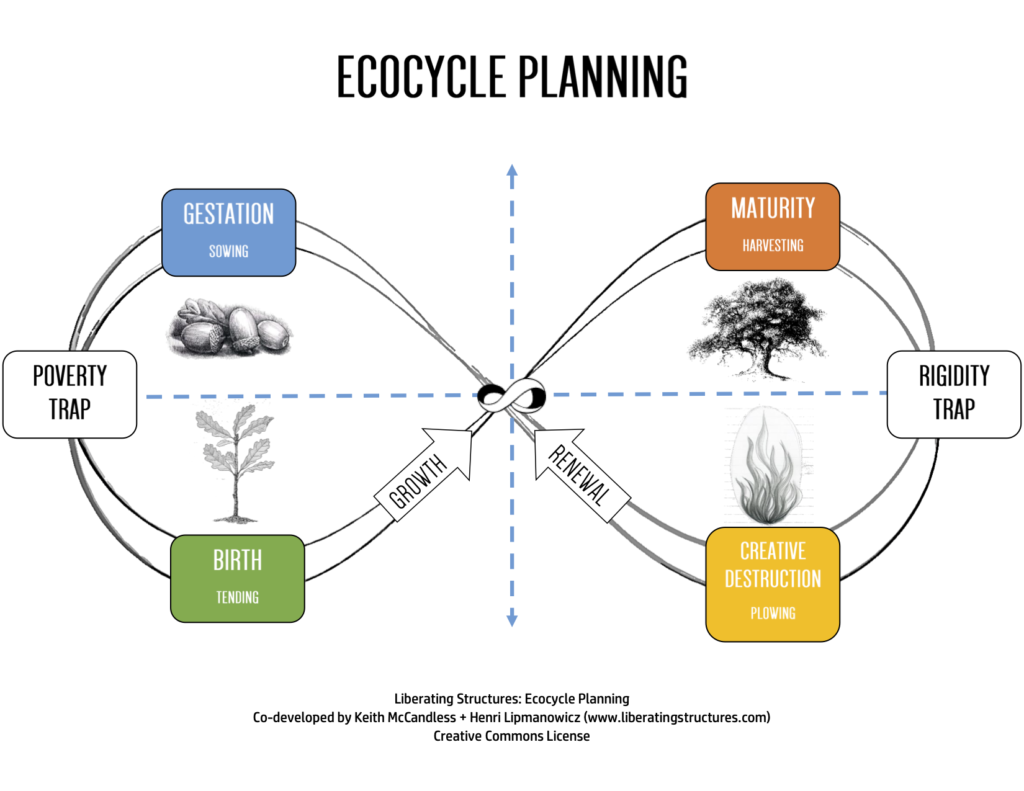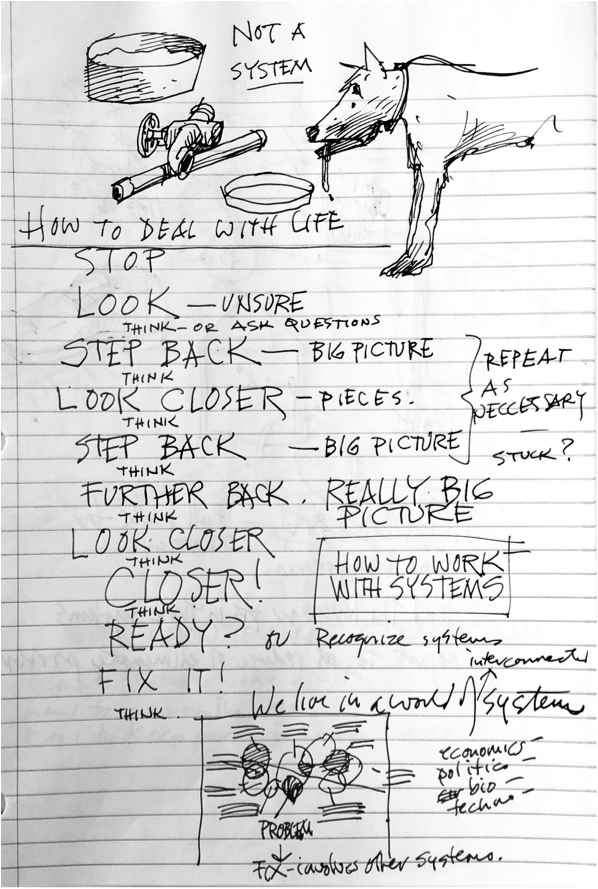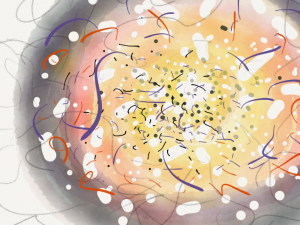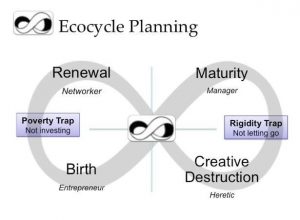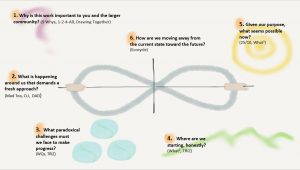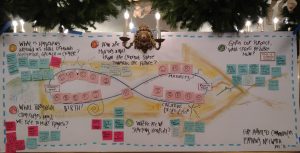This is 5th in a series of posts about the tidal wave of moving online in the time of Covid-19. #1, #2, #3 and #4 … Slide deck and artifacts for the event.

It is being said around the globe: move a bad meeting online and you have a terrible meeting. People are already in “zoom fatigue” and are “Zoombie Zombies.” The signal is loud and clear: we need to figure out what to stop doing so that we can focus on what is truly important.
In talking to people desperate to figure out their next move with strings of critical upcoming face to face (F2F) events, it has become clear that one way forward is to first DEconstruct. Get clear on the deepest purpose of each meeting or event. Figure out what NOT to do or to STOP doing, and prioritize only those things that will move them towards their goals. That was the signal I was sensing when I wrote about Ecocyle to notice what is shifting a couple of weeks ago.
Now is not the time to simply tick the task box as done.
I decided I wanted to engage my communities of practice in figuring out how to help people DEconstruct and then REconstruct. Thus was born the DEConstruct/REConstruct episodes. The idea is to put together a string (sequence) of Liberating Structures that groups can use on their own or with a facilitator to focus on essentials, and then, and only then, move into design and facilitation considerations of what is born anew through the process.
I asked one of the people calling for help if they would help us “learn in public” by going through a rapid version of the deconstruct/reconstruct (D/E) process online in a Zoom meeting. I proposed we would do this in a “fishbowl” context with the team from the organization being the fish swimming through the process, and observers in the fishBOWL (fish bowlers) first listening, then breaking out into small groups to offer questions and suggestions to the fish team.
By using this learning in public approach, we could also facilitate a few other things. Potential facilitators and consultants in the bowl could reach out and offer support (getting me out of the matchmaking position). And the wise crowd in the bowl could give suggestions to improve the process.
My friend and colleague Eva Schiffer brought her team as the fish for Episode 1 yesterday. This group has the challenge of redesigning what was going to be a two week field based capacity building program in an African country. There were multiple levels of travel – of the consulting team to the country to work with their government partners, then out into the field with private sector wildlife conservation partners. Now none of these folks can travel. AND the pandemic is creating an new challenge for those using tourism as a way to preserve ecosystems.
In preparation for the fish bowl I shared the six questions I’d ask and we spend just 30 minutes on a call to walk through the process. Through some email back and forth there were just initial consideration of the questions because we wanted the conversation to be fresh and alive during the Zoom gathering. I also set up a Google Slides deck with the meeting agenda, process overview, a slide for each of the six questions for note taking, and then templates for note taking by the fish after their breakouts.
By start time we had 48 people on the call (out of 66 registered), six fish and the rest bowlers. After brief verbal introductions of the fish, and text introductions by the bowlers, we dove in with a story of their current challenge.
Next we launched into the deconstruct using the six questions from Strategic Knotworking. Here are the six questions.
- What is the deepest purpose of our work through this gathering and why?
- What is happening around us that demands change (in how we were planning this gathering –go deeper than social distancing if possible!)?
- What challenges and wicked questions do we face in achieving our purpose?
- Where are we starting, honestly?
- Based on what we have learned, what is now possible?
- What is our first step and how will we know we are making progress towards our purpose?
Over the course of the next 45 minutes we focused primarily on question 1, around purpose, really digging past the signposts of their contract deliverables. Then we spent a few minutes on questions 2-4 to set context, challenges and baseline. I mentioned that question 4, “where are we starting, honestly” really benefits from a deeper look and suggested the use of Ecocycle Planning both to map out their project activities AND relationships. The team consistently talked about the importance of relationship and trust which typically they develop and deepen in F2F moments.
Finally we got to the really juicy question, “based on what we have learned, what is possible now?” That is when I felt the shift from what was, to what is now possible. The team thoughtfully balanced both their responsibility to their client (contract, deliverables) and the unique opportunity afforded by the shift online. Instead of the human and financial constraints (we can send the four people who are willing to travel), they realized they could tap more widely into the talents of their own team beyond the four. They could potentially engage more of their government clients and their private sector partners at a time when those partners are most stressed and could use support, even if there was no immediate money or business deal to be had.
Next we did breakout groups of 4-6 with the bowlers where they formulated a sharp, insightful question(s) and their most salient advice for the fish. They put these in dedicated slides (one for each group). While the bowls were doing this, the fish went into their own breakout room to make sense of what was happening. This unplanned innovation proved really helpful for the fish. So I want to repeat that twist – maybe keeping the fish in the main room so the facilitation team can learn from them. We’ll find out tomorrow when we try Episode #2
Take a peek at the insights from the Bowlers in slides 20-30 .
Finally, we did a VERY FAST (too fast?) What? So What? Now What? process and captured the insights in chat. I feel we could have gotten more out of this, but it was also important to stick to the 90 minute window.
Debrief
When faced with new constraints, we are able to leap past our old habits, assumptions and ruts. Something new becomes possible. This is at the heart of the idea of creative destruction and DEconstruct before REconstructing.
Looking across the amazing notes of the 7 bowl groups and the overall chat, including the debrief for those who stayed on for an additional 10 minutes, I think there was a) enough value to repeat this experiment next week with another NGO, b) gather and share a bit more information for the bowl folks so everyone get dive in quickly, and c) run the experiment one more time to see which questions deserve what amount of time.
We rushed through some great stuff, probably missed some stuff and really filled the 90 minutes, but it would have been wonderful to get the bowl engaged sooner and more interaction between the fish and the bowl. It would have been really wonderful to let the fish debrief themselves before we finished. That is lot in 90 minutes.
I was surprised that some actionable ideas emerged even before we got to the action planning question #5 – particularly Liberating Structure ideas that could be used in the deconstruction and assessment elements that could pull out some of the more complex issues and help the team prioritize actionable next steps.
As I second guess myself, I need to remember that my goal was not that these experiment could be fully completed – the full deconstruct and reconstruct – in 90 minutes, but to start the process. To explore and test the process. To connect people around the process. I think many of us hungered to fully DO the process which tugs at us. We want good things for each other and results. So I need to frame that this is a starting point.
I’m not sure if anyone followed up with anyone for the matchmaking intention. We’ll see if that shows up. I plan to check back with my fishes over the coming weeks to see what happens and will invite them to write up their reflections if that is helpful.
If you would like to be the FISH in the DE/RE bowl, please leave a comment before. We have more facilitators stepping up to do more!
Resources:
- Look for registration info on other events: https://ls.qiqochat.com/events
- Check out the LS Slack Instance, #deconstructreconstruct channel Liberating Structures Slac.: Other channels of interest: #pandemicresponse #virtual #tools
